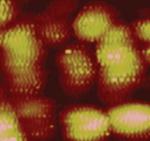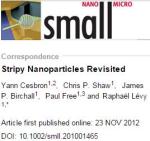If you are familiar with the controversy and wonder why a PloS One comment thread disappeared today, skip directly to recent events.
In 2004, Alicia Jackson (now deputy director of the Biological Technologies office at DARPA), Jacob Myerson and Francesco Stellacci (now Constellium Professor at EPFL) mis-interpreted a common scanning probe microscopy artefact for a real structure. They submitted their results to Nature Materials, which published the work. This error was to become the starting point of a controversy which, more than 10 years later, is still unraveling.
In 2005, concerns were raised by Predrag Djuranovic, then a student in Francesco Stellacci’s group. According to Lauren Wolf writing for Chemical & Engineering News last year:
… he discussed his concerns with his department head at MIT […]. A few months later, an official investigation of Stellacci launched at MIT and Djuranovic left Stellacci’s research group. MIT closed its review three years later, in 2008, finding Stellacci not guilty of academic misconduct. The university did, however, suggest that Stellacci should do additional work to substantiate his 2004 findings.”

MIT’s Building 10 and Great Dome; adapted from this pic
MIT was not convinced by the published data but instead of sharing those concerns with the scientific community, they kept them secret and Stellacci was asked to “substantiate” what he had published. This –trying to substantiate a structure which had been postulated to explain an experimental artefact– is what he has now been doing for more than 10 years… with over 30 articles published.
The controversy entered the public domain in 2012 with the publication of our article entitled Stripy Nanoparticles Revisited in Small: I was not aware of Predrag’s work but had come to the same conclusion. Francesco Stellacci published his response alongside our paper. He, and co-authors, also published several other articles around the same period. At the end of last year, Julian Stirling, and co-authors, published in PloS One an extensive Critical Assessment of the Evidence for Striped Nanoparticles which demonstrates that there is no evidence for the existence of the stripy nanoparticles. A response from Francesco Stellacci is still expected at PloS One.
Scientists interested in the details of the scientific arguments can refer to the articles linked to above (and references therein) as well as the blog posts and PubPeer discussions.
I wish this was all about science and differences of interpretation. I have touched previously on the re-use of figures in different articles. This eventually led to two corrections, one at Nature Materials and one at PNAS. An EPFL investigation was triggered, opened, and, eventually, following the report of an international independent panel, closed. A third article, pretty much entirely based on data re-use, has not been corrected.
I decided to start blogging about the controversy after the publication of our article in 2012. I used the blog to present our paper, discuss the response (without having to wait three years), publish an invited post from Predrad Djuranovic, other experts (Philip Moriarty, Mathias Brust, and Quanmin Guo), and many other things . Other blogs and the post-publication peer review platform PubPeer also became important fora.
Unfortunately, just as the traditional literature has its flaws and can be gamed by scientists who do not respect the rules, so do these new modes of scientific communication. I have argued earlier that the stripy controversy was a window into the scientific process revealing the serious failures of self correction mechanisms. It is also a window into the frightening flaws of online post-publication peer review – I say this as a strong and determined supporter of post-publication peer review.
Those who believe in stripes have never engaged openly in the online debate (they have even vigorously complained that it was taking place, likening it to cyberbullying). Instead, we’ve had, in chronological order:
- a troll posting over a period of two days a large number of comments on this blog… he eventually was identified as an Editor of the journal.
- A fakerapha blog (that still exists) and a fakerapha twitter (the account has been removed) who impersonated me on the Chembark blog.
- A text book case of Gish Gallop by “unreg” (a debating technique named after, and often used by, creationists) at PubPeer, It is to their immense credit that Julian Stirling, Philip Moriarty and several anonymous peers have engaged, repeatedly and honestly with “unreg”… until it became absolutely beyond doubt that this was no ordinary – if a little heated – discussion. Maybe best to let Nanonymous, an anonymous but insightful and regular commentator of the controversy describe that thread:
Wow, the same thing again and again, in spite of being addressed again and again.
and later
[…] it is interesting to reflect on the motivations for comments like these. They seem to come from an identity that either: 1)Does not understand basic scientific reasoning.2)Is vested in obfuscating some fairly straightforward arguments against clear and obvious errors in scientific work.Perhaps both. It could be just some random troll, but clear evidence that there are people acting in very bad faith out there. Nanonymous
- Possibly that thread also includes sockpuppetry with “unreg” and “ProfSTM/BioNanoChair” being the same person.
These things happened on blogs or at PubPeer, i.e. platforms which accept anonymous writing. It is hard to think of how they could be completely avoided while retaining anonymous comments. The discussions of the costs/benefits of anonymous post-publication peer review is ongoing (I agree with Peer 1 in that thread).
In the last few weeks, the stripy nanoparticles discussion has moved to PloS One which enables comments directly on the article. Plos One has a clear policy requiring contributors to “unambiguously identify themselves with their first and last names, their geographic location, […] Any registered user who is found to have provided false name or location information will have their account suspended and any postings deleted.” In spite of this:
- A “Gustav Dhror” posted over 10 comments (Gish Gallop again) about “Problems with Fig 4”. There is simply no doubt that Gustav is not a real person but instead a sockpuppet. There is no person with that name who has ever published any article on anything, let alone STM, nanoparticles or surface science. Even first year PhD students get their names listed on some website in academic institutions but “Gustav Dhror” draws zero hits on Google, or more precisely two: the PloS One thread and a baby name website. After I posted a comment (and contacted PloS One) raising the issue of false identity, that thread stopped… but a few days later…
- A “Dr Wei Chen” started another thread entitled “Multiple flaws with this paper“. The user profile linked to a real and existing Wei Chen, Professor at Suzhou Institute of Nano-Tech and Nano-Bionics in China. Given the context and previous events, I eventually took the liberty of calling Wei Chen to check whether he was “Wei Chen”, commenter at PloS One. And he was not. He had no idea. He had never posted anything at PloS One. Someone had stolen his identity to post these comments. Someone who wanted to discredit our paper (with flawed pseudo-scientific arguments), was not prepared to do it under their own name, but was prepare to steal someone else’s identity to do it.
PloS One has been contacted and has now removed the “Dr Wei Chen” thread. They have been in contact with “Gustav Dhror” and should post a statement regarding that thread tomorrow. In the paragraphs above, I have used links to WebArchives where you can see how the pages looked like this morning.




Who could have imagined that scientific debate could sink to such levels? Not this naive old git, anyway. Whilst anonymity has clear advantages, it also has great potential to bring out the worst in people. Keep up the fantastic work. This whole drama is a great test case for how the scientific process functions now.
LikeLiked by 1 person
Thank you Alan.
LikeLike
It is just depressing that this could happen, despite how easy it would be to do. It seems to be entirely indicative of the virus engulfing science in some quarters: We have here a situation where a group(?) of people are so afraid of admitting any mistakes, presumably for fear of losing a reputation (and funding) originally gained by dubious practices, that they are prepared to break the law. The incentives in modern science are totally wrong-ended and it seems to me that this kind of situation will only become more common if we continue on this path.
LikeLike
Levy contacted wrong Wei Chen, there are many Wei Chen in Suzhou. It is very unfair comments are removed from PLOS ONE website. Please respect my scientific comments and my person. Scientific comments should be considered independent who raised them.
LikeLike
Are you affiliated with http://english.sinano.cas.cn/au/bi/?
LikeLike
Wei Chen words have been taken down by Levy. Justice should prevail!
LikeLike
Levy & Moriarty do not accept critique. Long live Wei Chen!!!!!
[Raphael: I have cut the PloS One thread. It is available in the web archive which I have created and which is linked in this post; it is also available at PubPeer. There is no censorship of criticism, not even of absurd, crap flooding criticism, but no impersonation here. I have also remove 7-8 other comments which amounted to spamming]
LikeLike
I want to here more about the MIT revelations
LikeLike
It seems very clear to me that there is a single identify between fakerapha, unreg, ProfSTM, BioNanoChar, Gustav, Weichen (who is now crank spamming this blog and the PLOS comments section).
If other stories and studies on trolling are any indication, this person is probably quite pleasant in real life. Hard to guess at any motivation here other than being vested in obfuscating Stirling et al.’s clear and correct conclusions.
Whoever our dear trollfriend is, you’ve made it quite obvious to anyone that you are threatened by the conclusions of Stirling et al. Please do consider engaging in some more creative comments though, that will make it more fun for the rest of us. What do you think about the hairy ball theorem?
LikeLike
Your words haven’t been silenced! They are available at the PubPeer website, as are my responses.
Raphael asked you a very simple question, which you have ignored. Instead of spamming the comments section here and at PLOS ONE, please answer the question. If you are affiliated with the Suzhou Institute of Nano-tech and Nano-bionics then please definitively state this.
The problem is demonstrated by this link: http://lmgtfy.com/?q=Wei+Chen+Suzhou+Institute+of+Nano-tech+and+Nano-bionics+
Your PLOS ONE profile includes a link to the Suzhou website. The only Wei Chen who is listed at that website is http://sourcedb.sinano.cas.cn/yw/peo/facultyorstaff/201005/t20100518_2847745.html
If you are not that Wei Chen, don’t you think that it is your responsibility to point this out in your profile or in your comments at the PLOS ONE website? Wouldn’t that be the honest and ethical thing to do?
The reason your comments have been removed at the PLOS ONE site is nothing to do with “silencing” you, as you know full well. It’s because your profile identifies you directly with a Wei Chen at Suzhou who states categorically that he has not posted the comments. PLOS ONE obviously can’t have comments at their website whose source could be misattributed.
So, instead of blitzing the comments section here and elsewhere, why don’t you act answer Raphael’s question — are you affiliated with Suzhou?
LikeLike
Just realised that the sentence starting “If you are not that Wei Chen…” should have started “As you are not that Wei Chen…”
Apologies.
LikeLike
Raphael,
The latest post on pubpeer:
https://pubpeer.com/publications/58199FBEA31FB5755C750144088886#fb23615
falsely attributes authorship to my handle. It is certainly the same troll who has been spamming recently. My response isn’t showing up on pubpeer yet, I post it below. My, this is getting quite silly. I’m afraid the “encyclopedia dramatica” aspects will detract from the serious nature of the debate. I will probably sign up as registered peer to avoid this.
——————————————————————————————
The above post (Unreg February 1st, 2015 6:04pm UTC ) was not written by the real nanonymous (me). The poster (who is quite clearly associated with all the gish galloping) uses a deliberately sacchrin tone, perhaps for the purposes provoking a “spot the impostor” cliche:
http://tvtropes.org/pmwiki/pmwiki.php/Main/SpotTheImposter
The persistence of anonymous handles is a measure of how untrustworthy a forum can be, the fact that the above Unreg has approriated a handle that is not his/her own (this was already done once on the fakerapha site, there is no doubt that it is the unreg above is the same identity that is responsible for that site).
This is an attack against the utility of PubPeer since we must presume that the vast majority of comments that do not mention Russian brides, Nigerean banks or viagara are written in good faith and that no one would appropriate an established handle in good faith. This clearly demonstrates that we need to figure out ways around these attacks, we all knew this was inevitable. While the PubPeer admins certainly don’t have time, one could envision some sort of digital signature type scheme in PubPeer 2.0. (there are probably a few good reasons we don’t want mere registered usernames).
Suppose I don’t have much choice but to retire the moniker, any further posts labelled “nanonymous” are not written by me, the identity that assumed the (relatively) novel name during the course of learning about the stripy saga. I may consider joining as a regular Peer with my academic address, but will need to consider carefully for a bit.
I always thought that no one could possibly vest so much time and effort into trying to obfuscate facts about (what are to that vast majority of people) obscure subjects like nanoparticles but fakerapha/unreg/bionanochair/ProfSTM/gustav/weichen/etc. has proven me wrong. Learning that one is wrong anout something is perhaps the part that is most fun about internet discussions.
LikeLike
I did guess as much. The impersonator did not quite master your inimitable style. I’d give them a rather poor mark actually.
LikeLike
Signing is already possible already using GPG, but I guess not many want to see huge chunks of GPG signature underneath each post… or would want to check each for validity.
LikeLike
… and Wei Chen is back on PLOS One, ostensibly from SINANO. Allegedly after discussion with PLOS One editors (see end of his copy-paste post).
LikeLike